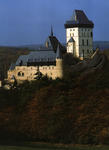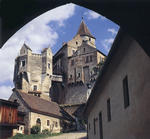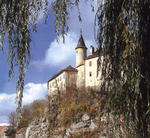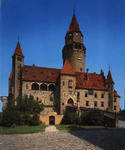Although insignificant in terms of size the Czech Lands (Bohemia and Moravia), situated in the very heart of Europe, have been a major crossroads of trade routes and cultural influences since their early history. Stimuli from the Mediterranean merged with those from the Orthodox East but during the 10
th century met with the gradually increasing influence of the Latin West to form a cultural area of which the Czech lands are a part. All this exerted a great impact on domestic activities. Due to their strategic location, the Czech Lands offered not only excellent opportunities for fruitful cultural exchanges, but were also exposed to a permanent threat of armed attacks from more powerful neighbors. Efforts to withstand this pressure, along with the need to develop a firm administrative base in the country, resulted in the establishment of an extensive system of feudal seats patterned on western examples. These structures of various designs and functions gradually replaced the network of ancient Slav settlements built until the 12
th century.
Modest watch and
defense castles, built either on rocks and hills or surrounded by water, sharply contrasted with the splendour of stately castles, the representative symbols of royal power. These splendid feudal seats were built especially in the second half of the 13
th century, during the reign of the last Premyslids. A real upsurge in constructing activities occurred however, in the middle of the 14
th century, during the reign of Emperor
Charles IV., when Bohemia became the centre of the most powerful empire in Central Europe.
With the arrival of a new lifestyle in the middle of the 16
th century, comfortable secular and ecclesiastical manor houses and chateaux began to be built, usually constructed on flat easily accessible land: their network

expanded very quickly.
Chateaux, conceived either as administrative centres or residential homes, recreational resorts, and other kinds of structures, adopted architectural styles and artistic morphology according to the time of their origin and in compliance with the demands, needs, and financial possibilities of their owners.
Over two thousand castles, chateaux, keeps, and castle ruins have been preserved in Bohemia and Moravia. This exceptionally dense network of noble homes, which only a few countries in Europe can match, contains a wealth of artistic and historical collections.
Despite the loss caused especially as a result of a lapse after World War II. in the country's continuous development, visitors'
expositions and various exhibitions staged in castles, chateaux, and other historical monuments, currently open to the public, bear witness to a dignified and representative cultural heritage which has survived to date in this historical territory of Bohemia and Moravia.



 Guide
Guide 





